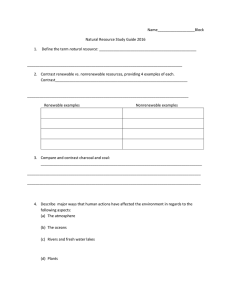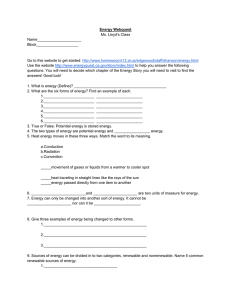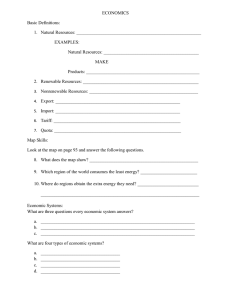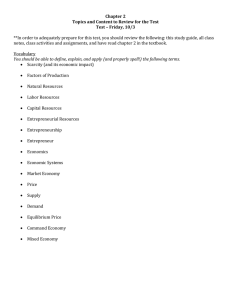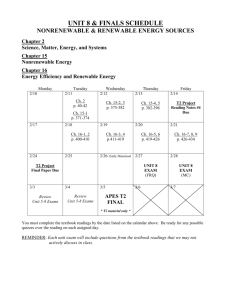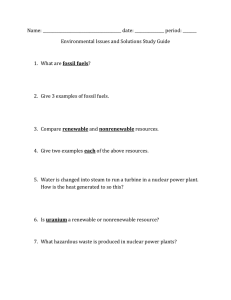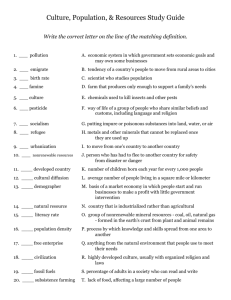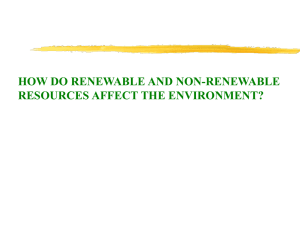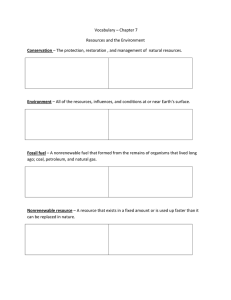Content Benchmark E.8.C.7 resources found in Nevada. E/S
advertisement
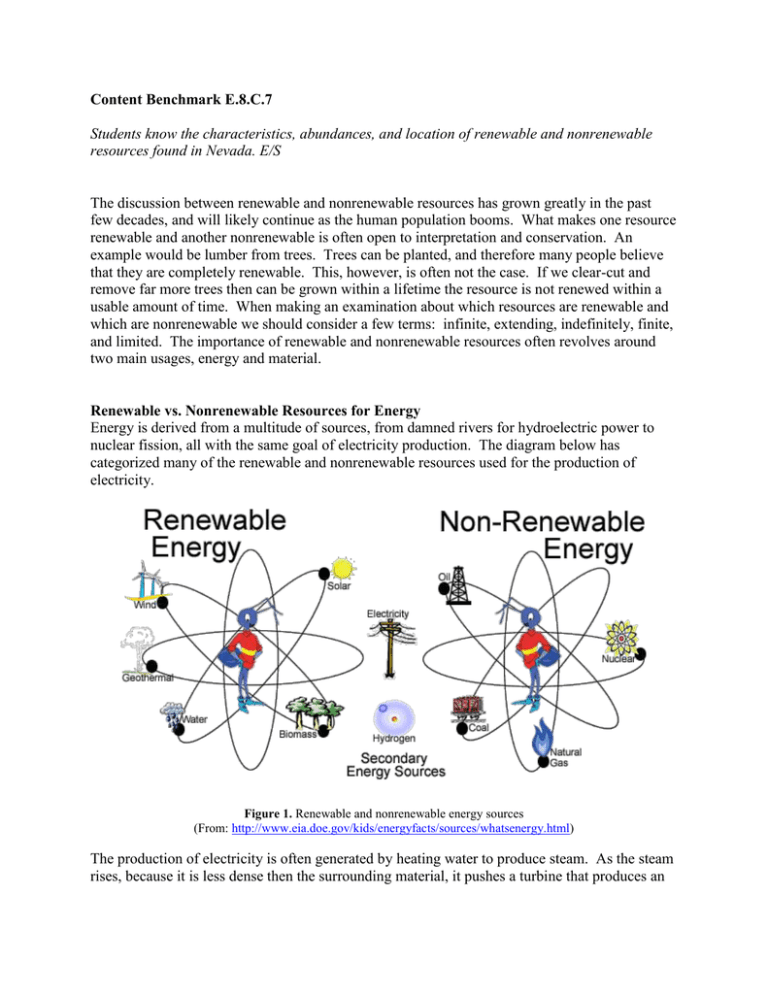
Content Benchmark E.8.C.7 Students know the characteristics, abundances, and location of renewable and nonrenewable resources found in Nevada. E/S The discussion between renewable and nonrenewable resources has grown greatly in the past few decades, and will likely continue as the human population booms. What makes one resource renewable and another nonrenewable is often open to interpretation and conservation. An example would be lumber from trees. Trees can be planted, and therefore many people believe that they are completely renewable. This, however, is often not the case. If we clear-cut and remove far more trees then can be grown within a lifetime the resource is not renewed within a usable amount of time. When making an examination about which resources are renewable and which are nonrenewable we should consider a few terms: infinite, extending, indefinitely, finite, and limited. The importance of renewable and nonrenewable resources often revolves around two main usages, energy and material. Renewable vs. Nonrenewable Resources for Energy Energy is derived from a multitude of sources, from damned rivers for hydroelectric power to nuclear fission, all with the same goal of electricity production. The diagram below has categorized many of the renewable and nonrenewable resources used for the production of electricity. Figure 1. Renewable and nonrenewable energy sources (From: http://www.eia.doe.gov/kids/energyfacts/sources/whatsenergy.html) The production of electricity is often generated by heating water to produce steam. As the steam rises, because it is less dense then the surrounding material, it pushes a turbine that produces an electric current. Wind power skips the steam process and uses the wind to turn the generator. Solar power, photovoltaic cells, uses the Sun’s transferred energy to induce an electrical current. To learn more about the production of energy go to http://www.powerhousekids.com/stellent2/groups/public/documents/pub/phk_eb_ae_001467.hcsp. Nonrenewable Resources Of the energy sources listed above, what makes nonrenewable resources nonrenewable is their limited amounts, and slow regeneration processes. Coal, natural gas, and oil (fossil fuels) are classified as nonrenewable not because they will never be produced again by Earth’s natural process, but because that process will take time in spans of millions of years. So, to humans with life-spans far less, fossil fuels are nonrenewable resources. Nuclear power, however, truly is a nonrenewable resource in that the presence of the fuel source (uranium 235) is finite on Earth. Renewable Resources The energy sources listed on the right of the diagram (figure 1) show energy sources that are either constant like solar, wind, geothermal and water (as in rivers or rain collection), or can be reproduced within a reasonable amount of time such as biomass. The Sun’s energy is constant and will be for at least the next 4.5 billion years. The fact that we, especially in Nevada, can harness that power allows it to be classified as a renewable resource. An interesting renewable resource is biomass. Biomass can be thought of as trees and other fast growing plants such as corn and Sudan Grass, and the waste products of lumber harvesting. Trees are a renewable resource as long as their removal doesn’t occur faster then their growth period. More interestingly the byproducts of trees, like bio-fuels and oils, are proving to be very promising as fossil fuel alternatives. For more information about renewable and nonrenewable resources used for energy production go to http://www.midamericanenergy.com/eew/learn/make.html. Figure 2. Ruby Hill open-pit gold mine picture (From http://www.mining-technology.com/projects/rubyhill/rubyhill1.html) Renewable vs. Nonrenewable Resources for Production What is most often heard in Nevada, as a great mining state, is that “If it isn’t grown, it has to be mined.” The mining process is a means of obtaining natural resources from the Earth. Resources like copper, gold, gypsum, etc., that are used in everyday life could be classified as both renewable and nonrenewable. The total amount of these resources on Earth is finite, but unlike resources used in energy production, the minerals are not destroyed when used. Water could easily be thought of as the most important natural resource for survival. Fresh water is relatively finite on this planet. Because it is a finite resource it could be thought of as a nonrenewable resource. However, due to the water cycle, it is constantly being recycled throughout the environment. The classification of water being a renewable or nonrenewable resource rests on our responsible use of this resource. Gold is another great example of a resource that could be classified as a nonrenewable or renewable resource. The gold in your computer could easily be used in jewelry just as it could easily be returned to the Earth through natural processes. What makes these resources limited (nonrenewable) is their inability to be easily accessed and or recycled within a timely manner. For example, the major gold deposits in Nevada were inaccessible until modern technology. Now, Nevada production accounts for 87% of the total US gold production and is the third largest producer in the world behind South Africa and Australia. Because minerals are mined according to their accessibility they are often classified as being a resource (mining is occurring) or as a reserve (they could be mined, but most likely it is cost prohibitive). Go to http://pubs.usgs.gov/of/2004/1244/ and “Download the movie as a PowerPoint file (9.8 MB) for full movie of mining activity in Nevada 1851-1995.” to see a historical profile of mining in Nevada. Go to http://www.nevadamining.org/education/mining_nevada/mineral_uses/ for the minerals produced in Nevada and some of their uses. Figure 3. Map of Nevada resources (From http://www.nbmg.unr.edu/dox/mi/06.pdf) Resources of Nevada Nevada is fairly abundant with natural resources. Many of Nevada’s resources are used in production, like copper, gold, and other valuable industrial minerals, with fewer energy resources. The map above clearly shows that most of the natural resources are located throughout the central and northern portions of the state. The southern counties are home to some industrial mining mostly for gypsum, clay, and lime. In Elko, Eureka, and northern Nye counties there are accessible resources of oil, along with many mineral resources. Most of the geothermal power plants reside in the northwest of the state. Nevada Division of Minerals web site has listed the resources of Nevada as PDF’s that can be downloaded. The site also contains links to location and type of mineral resources found in Nevada. For further information about Nevada’s mineral resources go to http://minerals.state.nv.us/ Content Benchmark E.8.C.7 Students know the characteristics, abundances, and location of renewable and nonrenewable resources found in Nevada. E/S Common misconceptions associated with this benchmark 1. Students mistakenly believe that renewable resources are permanent, and that nonrenewable resources will never be produced by Earth’s natural processes. This misconception, more than likely, stems from vocabulary usage of the word “renewable” and “nonrenewable.” Students often think that the word “renewable” when pertaining to resources means that there is a constant supply of material. This seems to only be true in two energy cases, the Sun’s radiation and the Earth’s radioactive core; but even those energy sources will eventually run out. Students also seem to think that if a resource is “nonrenewable” then once it is gone it will never return. This is untrue; in reference to fossil fuels, the time it will take for new organic material to complete the biogenic process, to turn into petroleum, takes millions of years. Due to the timeframes needed to produce and reproduce these resources they are described as nonrenewable or renewable resources. For further information about renewable and nonrenewable resources, go to http://www.eia.doe.gov/kids/energyfacts/sources/whatsenergy.html. 2. Students mistakenly think that all gold mining takes place in placer deposits (chunks of gold on the ground). When gold mining is first discussed or mining in general, students often think of the movies portrayal of a miner, knee deep in a river, panning for gold. This mental image is not incorrect, but it negates the many other mining practices currently used. For example, some major mining operations in Northern Nevada mine in distal-disseminated deposits and Carlin-type deposits. In these deposits, gold is either suspended in rock at a microscopic level, or chemically bound. For more information about the types of deposits and mining in Northern Nevada go to http://pubs.usgs.gov/fs/2005/3023/. 3. Students think that all or most of the natural resources for materials are contained within Earth’s crust. Students with even a basic understanding of the rock cycle, and Earth’s structure will quickly realize that the crust is an extremely thin layer of Earth when compared to the rest of Earth’s layers. A vast majority of Earth’s mineral resources are contained within the mantel, inner and outer core. For further information about Earth’s structure see MS TIPS Benchmark E.8.C.3. For further information about Earth’s rock cycle see MS TIPS Benchmark E.8.C.2. For further information about some of the minerals found in Earth’s layers go to http://www.seismo.unr.edu/ftp/pub/louie/class/100/interior.html. 4. Students think that all natural resources are rocks and minerals. Water, trees, fish, crops, and countless other naturally occurring resources are vital for human survival. Any or all of these resources could easily be classified as nonrenewable if they were not used responsibly. Fishing in an area at a rate above the fishes’ reproductive cycle would cause the resource to become more scarce and possibly extinct. If continued, the resource may become extinct and thus, nonrenewable. Water is another great example here in Nevada. The amount of water available in Nevada is limited by the precipitation in and around the state. This resource is often thought of as a nonrenewable resource due to the current rate of precipitation and its consumption. The responsible use of these natural resources will allow them to be renewable for future generations. To learn more about Nevada’s biological resources and their needs go to http://heritage.nv.gov/. For further information about Earth’s natural resources including: its minerals, energy, land, water, and biota, go to http://www.usgs.gov/themes/resource.html. 5. Students incorrectly believe that all precious metal deposits are profitable. The thought of mining a precious metal, such as gold, often conjures up images of large wealth. This is often not the case. The definition of an ore is a mineral or rock that can be mined at a profit. Gold ore could be available in an area, but if it costs more to extract the gold from the ore than the gold is worth on the market, the mine will not stay open. Resources need to be not only abundant, but easily processed in order for the mineral resource to be a mined ore. For more information about ores, and the usages of their elements go to http://www.minsocam.org/MSA/collectors_corner/article/oremin.htm. Content Benchmark E.8.C.7 Students know the characteristics, abundances, and location of renewable and nonrenewable resources found in Nevada. E/S Sample Test Questions Questions and Answers to follow on a separate document Content Benchmark E.8.C.7 Students know the characteristics, abundances, and location of renewable and nonrenewable resources found in Nevada. E/S Answers to Sample Test Questions Questions and Answers to follow on a separate document Content Benchmark E.8.C.7 Students know the characteristics, abundances, and location of renewable and nonrenewable resources found in Nevada. E/S Intervention Strategies and Resources The following is a list of intervention strategies and resources that will facilitate student understanding of this benchmark. 1. The Exploring Earth website does a great job of explaining natural resources that are both renewable and nonrenewable. The site’s slideshow has links to virtual fieldtrips through National Parks where the students can examine and list renewable and nonrenewable resources. This resource culminates with an activity that allows the students to produce a brochure for a National Park. For further information about this resource visit http://www.classzone.com/books/earth_science/terc/content/investigations/es0705/es0705pag e01.cfm. 2. The Nevada Bureau of Mines and Geology has a website that contains links to many valuable resources. This website is a hub with connections to everything from copper mining to geodes. The site provides links that could serve as the starting place for student projects, teacher education, educational mining resources, and many others. To access these resources go to http://www.nbmg.unr.edu/edlinks.htm. 3. The Environmental Protection Agency website has a three activity lesson plan designed to help students apply the pollution prevention concept to the use of energy. It provides guidance and activities that explain renewable and nonrenewable energy sources, and how pollution prevention concepts can be used to conserve energy. This site also offers a fact sheet with background information and the definitions necessary to implement this lesson plan. To access this resource go to http://www.epa.gov/reg5rcra/wptdiv/p2pages/energy.pdf 4. The Women in Mining website offers many classroom activities on mineral and resource education. Some activities are targeted at conservation of nonrenewable resources; mineral processing; mining steps, including how to find, extract, process and use mineral resources; core sampling techniques; how to produce a marketable mineral product; and economic factors of the minerals resources. This resource provides on the spot lessons and activities to aid in the students’ understanding of natural resources. For more information about this site go to http://www.womeninmining.org/activity.htm. 5. The Department of Energy’s website offers many grade appropriate activities and labs that address renewable and nonrenewable resources that pertain to energy. The page is categorized by grade level, and has links to activities, labs, and lesson plans that would be available for immediate use. For more information go to http://www.eia.doe.gov/kids/classactivities/teachers&students.html 6. The Daily Lesson Plan has a lesson about the water as a natural resource. “Water, Water, Everywhere, Nor Any Drop to Drink. Water as a Limited Resource and the Technologies Created to Attempt to Best Use It.” The lesson involves a reading, which is hyperlinked at the site, questions, and points of discussion. For more information go to http://www.nytimes.com/learning/teachers/lessons/19981208tuesday.html 7. Cookie mining is a great way to introduce the concept of mining nonrenewable resources. This activity will help students discover what an ore is, to calculate % composition (as in % copper in an ore), understand the concept of waste produced during ore extraction (waste to get at the ore, waste from the ore), and understand the environmental impact of mining. This activity helps students conceptualize the mining process and allows them to gain a better understanding of renewable and nonrenewable resources. For a complete lesson plan, with resources, go to http://www.dlese.org/library/query.do?q=nonrenewable&s=0&gr=05.
